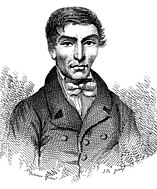
Back جرائم بورك وهير Arabic Assassinats de Burke i Hare Catalan West-Port-Morde German Murdoj de Burke kaj Hare EO Asesinatos de Burke y Hare Spanish Burke eta Haren hilketak EU قتلهای بورک و هر FA Meurtres de Burke et Hare French Dúnmharuithe West Port GA Burke–Hare-gyilkosságok Hungarian
The Burke and Hare murders were a series of sixteen murders committed over a period of about ten months in 1828 in Edinburgh, Scotland. They were undertaken by William Burke and William Hare, who sold the corpses to Robert Knox for dissection at his anatomy lectures.
Edinburgh was a leading European centre of anatomical study in the early 19th century, in a time when the demand for cadavers led to a shortfall in legal supply. Scottish law required that corpses used for medical research should only come from those who had died in prison, suicide victims, or from foundlings and orphans. The shortage of corpses led to an increase in body snatching by what were known as "resurrection men". Measures to ensure graves were left undisturbed—such as the use of mortsafes—exacerbated the shortage. When a lodger in Hare's house died, he turned to his friend Burke for advice and they decided to sell the body to Knox. They received what was, for them, the generous sum of £7 10s.[a] A little over two months later, when Hare was concerned that a lodger with a fever would deter others from staying in the house, he and Burke murdered her and sold the body to Knox. The men continued their murder spree, probably with the knowledge of their wives. Burke and Hare's actions were uncovered after other lodgers discovered their last victim, Margaret Docherty, and contacted the police.
A forensic examination of Docherty's body indicated she had probably been suffocated, but this could not be proven. Although the police suspected Burke and Hare of other murders, there was no evidence on which they could take action. An offer was put to Hare granting immunity from prosecution if he turned king's evidence. He provided the details of Docherty's murder and confessed to all sixteen deaths; formal charges were made against Burke and his wife for three murders. At the subsequent trial Burke was found guilty of one murder and sentenced to death. The case against his wife was found not proven—a Scottish legal verdict to acquit an individual but not declare them innocent. Burke was hanged shortly afterwards; his corpse was dissected and his skeleton displayed at the Anatomical Museum of Edinburgh Medical School where, as at 2024[update], it remains.
The murders raised public awareness of the need for bodies for medical research and contributed to the passing of the Anatomy Act 1832. The events have made appearances in literature, and been portrayed on screen, either in heavily fictionalised accounts or as the inspiration for fictional works.
- ^ UK Retail Price Index inflation figures are based on data from Clark, Gregory (2017). "The Annual RPI and Average Earnings for Britain, 1209 to Present (New Series)". MeasuringWorth. Retrieved 11 June 2022.
Cite error: There are <ref group=lower-alpha> tags or {{efn}} templates on this page, but the references will not show without a {{reflist|group=lower-alpha}} template or {{notelist}} template (see the help page).

